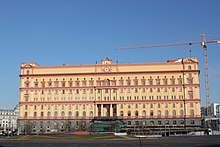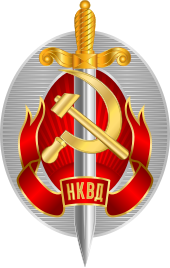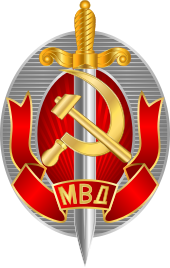Ministry of Interior of the USSR
The Interior Ministry of the USSR ( NKVD , later MWD ) emerged from the People's Commissariat for Internal Affairs of the RSFSR . In its history, he performed both the classic duties of a ministry of the interior and, at times, those of a political secret police and a secret service. From 1934 the NKVD and from 1946 to the MWD were responsible for the warehouse ( GULag ). After the dissolution of the USSR in 1991, the Interior Ministry of the Russian Federation became the legal successor to the MVD of the Soviet Union alongside the Interior Ministries of the successor states of the USSR - the former Union Republics .
As the name of the People's Commissariat of Internal Affairs , the abbreviation sat NKVD for N arodnyj k ommissariat w nutrennich d el (Russian НКВД = Народный комиссариат внутренних дел ) through which was in use from 1934 to 1946. The NKVD was founded in 1934 as the Soviet Union Ministry, to which the then secret police of the Soviet Union OGPU was incorporated as the most important department .
After the brief (1941) and renewed (1943) separation of the political secret police as NKGB , it was merged in 1946 with the counter-espionage organization SMERSch (for: Death to Spies ) to form the Ministry for State Security (MGB), from which the KGB emerged in 1954 . The NKVD was transformed into the MWD (abbreviation for M inisterstwo w nutrennich d el , Ministry of Internal Affairs ; Russian: Министерство внутренних дел) in 1946 . The term People's Commissar was replaced by Minister .
Development and tasks
During the tsarist times
As early as 1802, Tsar Alexander I created a ministry for internal affairs, which was responsible for the police , the domestic guards and oversight of the government authorities, making it one of the most influential institutions in the Tsarist empire . In addition, he was responsible for the administration of the prison system , fire-fighting , the state postal system , the administration of state property, construction, the maintenance of the streets, the medical system, the clergy , the disposal of natural resources and issues relating to the nobility . Many of these tasks were increasingly performed by independent authorities around the middle of the 19th century, so that the main focus was on questions of internal security, which became more urgent with the growth of anarchist and socialist movements. Secret service tasks were performed from 1881 to 1917 by the Ochrana , which was subordinate to the MWD; In addition, a separate counter-espionage department was set up.
After the October Revolution

The Bolsheviks , victorious in the October Revolution , soon set about building their own administrative structure to maintain internal security. The tasks of the Tsarist MWD were taken over by the People's Commissariat for Internal Affairs (NKVD) of the Russian Socialist Federal Soviet Republic , which was in fact a continuation of the old Tsarist MWD under new leadership.
On December 20, 1917, by decision of the party under the leadership of Felix Dzerzhinsky, the Soviet Russian State Security Service with the designation WTSCHK (Russian ВЧК, pronounced Ve-TSCHe-Ka , stands for Vserosiyskaya Tschreswytschajnaja Komissija (All-Russian Extraordinary Commission)) was founded . The first letter (W for all-Russian) is often left out, so the name becomes TSCHK (Russian: ЧК, pronounced like TSCHe-Ka). The CheKa , which the Bolsheviks called "the armed arm of the dictatorship of the proletariat ", was mainly used to fight the opposition, the counter-revolution and for foreign intelligence activities. In 1922 the Cheka became the GPU of the NKVD (RSFSR), and in 1923 it was transformed into an All-Union GPU (OGPU) under the Council of People's Commissars . In 1934, the OGPU became a GUGB in the All-Union NKVD that was newly formed from the NKVD of the RSFSR. The secret police apparatus of the Soviet Union was renamed several times in the following years (1941 in NKGB, later MGB, KGB ).
Over the years the Soviet Union's police force went through several partitions and mergers. At times the NKVD was also subordinate to the Soviet militia and the security services with the secret police of the USSR.
In March 1946, all people's commissariats were renamed ministries, the NKVD was given the old name MWD back. The RSFSR also received its own MWD again. The People's Commissariat for State Security (NKGB), subordinate to the NKVD, was also renamed, which was now called the Ministry for State Security (Ministerstwo gossudarstwennoj besopasnosti, MGB) and operated as the KGB from 1954.
The armed forces' secret service, which has existed since the Revolution, but was largely unknown, was the GRU (Glawnoje Raswedywatelnoje Uprawlenije, Main Intelligence Administration).
After Stalin's death
Immediately after Josef Stalin's death in March 1953, Lavrenti Beria ordered the merger of the MWD and MGB in order to gain the greatest possible power in the struggle for succession against Prime Minister Georgi Malenkov and party leader Nikita Khrushchev at the head of the organization thus created . A little later, in June 1953, Beria was overthrown at Khrushchev's instigation, the "super ministry" was again divided, with the MWD being assigned the police functions and the former MGB, now known as the KGB, as the state security service, the tasks of a secret police.
In 1960, Khrushchev ordered the dissolution of the MVD of the USSR as part of an administrative reform that was directed against excessive central bureaucratisation but was intended to strengthen the powers of the individual republics. In the Russian Union Republic, these tasks were taken over by the so-called Ministry for the Protection of Public Order from 1962.
Leonid Brezhnev , also reversed this action and in July 1966 re-created a Soviet Ministry of the Interior, the All Union Ministry for the Protection of Public Order, headed by Nikolai Shchyolokov and which in 1968 regained the old name MWD. One of the tasks of the MWD was the fight against white-collar crime, which in Soviet times included every form of independent entrepreneurship. However, large parts of the MWD leadership themselves were considered corrupt or influenced by the shadow economy and criminal gangs. Gorbachev's perestroika and glasnost policy , which began in the mid-1980s, was intended to ensure more transparency and reforms in this area as well.
The Russian MWD today
After Brezhnev had temporarily dissolved the MWD of the Russian Union Republic , it was rebuilt in 1990. After the dissolution of the USSR , it became the legal successor of the Union MWD alongside the interior ministries of the other successor states of the USSR.
Today the MWD is responsible for the militia (Russian Милиция; since March 1, 2011 renamed to Polizija (полиция); i.e. the regular police forces), for the supervision of the state roads, as well as for the around 20,000 men of the special police unit OMON ( Russian ОМОН ), who are responsible for emergencies, internal conflicts and the protection of the nuclear arsenal.
The Russian domestic intelligence service is now the FSB (Federalnaja Sluschba Besopasnosti), which emerged from the KGB. The secret service in Belarus continues to be called the KGB.
State Security Services
→ Main articles: Cheka , GPU , KGB , FSB
In addition to the Ministry of the Interior, or at times within it, there was also a State Security Service (state police, secret service), which was often renamed:
- 1917: WTSCHK (We-TSCHe-Ka) (Vserossijskaja tschreswytschainaja komissija po borbe s kontrrewoljuziej, spekuljaziej i sabotaschem = Extraordinary All-Russian Commission to Combat Counterrevolution, Speculation and Sabotage)
- 1922: GPU (Gossudarstvennoje polititscheskoje uprawlenije = State political administration, within the NKVD of the RSFSR)
- 1923: OGPU (Objedinjonnoje Gossudarstvennoje Polititscheskoje Uprawlenije = United State Political Administration of the USSR)
- 1934: GUGB (Head Office for State Security within the NKVD)
- 1941: NKGB ( People's Commissariat for State Security )
- 1946: MGB ( Ministry for State Security)
- 1954: KGB (Committee for State Security) (dissolved November 6, 1991)
- 1991: MB in Russia (Ministry of Security)
- 1993: FSK in Russia (Federal Counter-Enlightenment Service - ФСК)
- 1995: FSB in Russia (Federal Security Service)
State terror by the Ministry of the Interior (NKVD)
"Purges", forced relocations and gulags
Without a trial or in trials without the rule of law, people were often sentenced to years or life in a labor camp ( gulag ) or to death. ( Butowo , Butyrka , Kurapaty , Kolyma ). Most of the former leaders of the NKVD up until the early 1950s were later disgraced and shot.
The interior authorities and the state security services are responsible for massive acts of state terror that are mostly unfounded even under Soviet law :
- The forced resettlement and murder of many ethnic groups: For example, in 1941 after the beginning of the German-Soviet war, the Volga Germans were deported to Siberia and Kazakhstan (on suspicion of being disloyal to the Soviet Union). Between 1944 and 1945, around 500,000 Chechens and Ingush , three to four hundred thousand Balkars , Kalmyks and Karachays and 160,000 Crimean Tatars were abducted. According to NKVD reports, up to 500,000 of the more than 1.5 million forced deportees lost their lives in this alone (like the Volga Germans, they were accused of disloyalty). A total of 7.5 million were deported, of which 1.7 million died.
- The shootings of many actual or alleged critics of the regime in the context of the so-called Great Terror or the Stalin Purges (1936 to 1939): 1.5 million were executed, 5 million died in the Gulag.
- The murder of 26,500 prisoners of war Polish soldiers and officers, including in the Katyn massacre (1940).
- Around one million German prisoners of war and civilians lost their lives as a result of the deportation .
NKVD commands
Some well-known orders of the NKVD in the context of the mass operations of the Great Terror, in the order in which they were issued:
- NKVD command No. 00439 = German operation of the NKVD
- NKVD order no. 00447 = so-called "kulak operation"
- NKVD command No. 00485 = Polish operation of the NKVD
- NKVD Order No. 49990 = Latvian Operation of the NKVD
POW camps and labor camps
The prisoner-of-war camps also belonged to the responsibility of the NKVD and MWD during and after the Second World War . For this purpose, the main administration for matters of prisoners of war and internees (GUPWI) was set up in the NKVD . The interior authorities decided on the locations and facilities of the camps, on the treatment and use of prisoners of war and also decided on their repatriation. The now accessible personal files on all prisoners of war - Utschetnoe Djelo / Russian Учётное Дело - are in the custody of the Federal Archives Service of Russia - Reich Foundation - Russian Reich War Archives (RGWA), Moscow . Secret service material collected from the prisoners of war is evidently stored elsewhere and is not (yet) accessible.
After the end of the Second World War, the NKVD was also responsible for the special camps in the Soviet occupation zone .
The interior ministers (before March 16, 1946 people's commissars) and the heads of the security organs
- 1. Alexei Rykov (1917–1918), shot in 1938
- Felix Dzerzhinsky (1917–1920), State Security (TSCHeKa)
- 2. Felix Dzerzhinsky (1920–1923), Internal Affairs and State Security (TSCHeKa, GPU), then until 1926 only State Security
- 3. Alexander Beloborodov (1923–1927), shot in 1938
- 4. Vyacheslav Menschinsky (1927–1934), Home Affairs and State Security (OGPU)
- 5. Genrich Jagoda (1934–1936), Interior and State Security (NKVD) shot in 1938
- Nikolai Jeschow (1936–1938), only State Security (NKVD), shot in 1940
- 6. Filaretow (1936–1938) only interior
- 7. Lavrenti Beria , 1st time (1938–1941), Interior and State Security (NKVD), shot in 1953
- Vsevolod Merkulov (1938–1941), only State Security (NKGB), shot in 1953
- 8. Lavrenti Beria, 2nd time (1941–1946, Home Affairs and State Security (NKVD, NKGB))
- 9. Sergei Kruglow (1946–1953) only interior;
- Viktor Abakumow (1946–1951), State Security only (MGB), shot in 1954
- Semjon Ignatjew (1951–1953), State Security only (MGB)
- 10. Lavrenti Beria, 3rd time (1953), Internal Affairs and State Security (MGB)
- 11. Sergei Kruglow , 2nd time (1953–1956) only interior;
- Ivan Serow (1954–1958) only State Security (KGB)
- 12. Nikolai Dudorow (1956–1960), only interior
- Alexander Schelepin (1958–1962), only State Security (KGB)
- Vladimir Semitschastny (1962–1967), only State Security (KGB)
From 1960 to 1968 there were interior ministers only in the Union republics
- 13. Nikolai Shcholokov (1968-1982);
- Yuri Andropov (1967–1982), State Security only (KGB)
- 14. Vitaly Fedorchuk (1982-1986); 1982 briefly also state security
- Viktor Tschebrikow (1982–1988), only State Security (KGB)
- 15. Alexander Vlasow (1986–1988), only interior
- 16. Wadim Viktorovich Bakatin (1988–1990), only interior
- Vladimir Kryuchkov (1988–1991), only State Security (KGB)
- 17. Boris Pugo (1990 – August 1991), only interior
- 18. Viktor Barannikow (August – December 1991), only interior
- Wadim Bakatin (August – December 1991) only state security (KGB)
The two tasks of home affairs and state security were temporarily led by a head:
- 1920 to 1923 by Felix Dzerzhinsky
- 1928 to 1934 by Vyacheslav Menschinsky
- 1934 to 1936 by Genrich Jagoda
- 1936 to 1938 by Nikolai Jeschow
- 1938 to 1941 from Lavrenti Beria
- March – June 1953 by Lavrenti Beria
See also
literature
- Bertold Spuler : Regents and Governments of the World. Minister-Ploetz Vol. 4 u. 5, 1964 and 1972, ISBN 3-87640-026-0 .
- Simon Sebag-Montefiore : Stalin - At the court of the red tsar. S. Fischer, Frankfurt am Main 2005, ISBN 3-10-050607-3 .
- Merle Fainsod : How Russia is governed. Kiepenheuer & Witsch, Cologne 1965.
- Alexander Jakowlew: A Century of Violence in Soviet Russia. Berlin Verlag, Berlin 2004, ISBN 3-8270-0547-7 .
- Reinhard Müller : NKVD torture. Terror Reality and Production of Fictions. In: Stalinscher Terror 1934-1941: a research balance sheet. Ed. Wladislaw Hedeler , Basisdruck, Berlin 2002, pp. 133–158.
- Reinhard Müller: "Endless horror". Submissions by German NKVD prisoners and their relatives to Stalin, Jeshow and others. a. In: exile. Research, findings, results , Volume 17, 1997, Issue 2, pp. 63-88.
- Ronald Rayfield: Stalin and his executioners. Karl Blessing, Munich 2004, ISBN 3-89667-181-2 .
- Vladimir F. Nekrasov (Ed.): Berija. Executioner in Stalin's service. End of a career. Ed. q, Berlin 1992, ISBN 3-928024-69-8 .
- Anne Applebaum : The Gulag. Siedler, Berlin 2003, ISBN 3-88680-642-1 .
Web links
- www.nkwd.org - site about the victims and crimes of the NKVD regime (English, Russian)
- Official history of the Russian interior ministries from 1801 to the present day (Russian) ( Memento of October 24, 2007 in the Internet Archive )
- http://www.nkwd-und-gestapo.de/index.html
Individual evidence
- ^ Ralf Stettner: The GULag of the NKVD / MWD 1934-1956 . In: "Archipel GULag". Stalin's forced camp - a terrorist instrument and economic giant. Verlag Ferdinand Schöningh, Paderborn 1996, ISBN 3-506-78754-3 , p. 133 f.
- ↑ On the centenary of the Cheka-OGPU-NKVD-KGB-FSB , Novaya Gazeta , December 21, 2017


